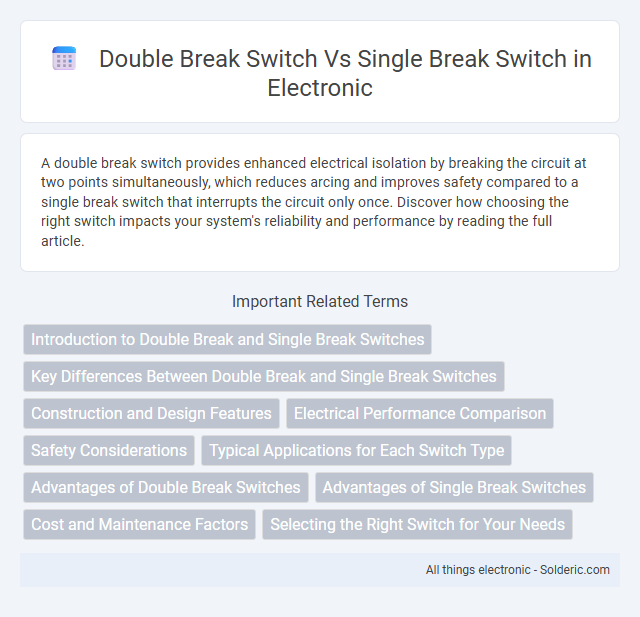A double break switch provides enhanced electrical isolation by breaking the circuit at two points simultaneously, which reduces arcing and improves safety compared to a single break switch that interrupts the circuit only once. Discover how choosing the right switch impacts your system's reliability and performance by reading the full article.
Comparison Table
| Feature | Double Break Switch | Single Break Switch |
|---|---|---|
| Contact Break Points | Two points of contact interruption | One point of contact interruption |
| Arc Quenching | More efficient arc interruption | Less efficient, higher arc duration |
| Current Interruption | Better handling of higher current loads | Suitable for lower current ratings |
| Switching Speed | Faster operation due to double break | Relatively slower operation |
| Cost | Higher cost due to complex design | Lower cost, simpler design |
| Applications | High voltage and heavy industrial use | Low voltage, residential, and light commercial use |
| Maintenance | Requires regular maintenance | Less maintenance required |
Introduction to Double Break and Single Break Switches
Double break switches feature two interruption points within the circuit, providing enhanced arc extinction and improved reliability compared to single break switches, which have only one interruption point. Single break switches are simpler and typically used for lower voltage applications, while double break switches are preferred in medium to high voltage systems for their superior performance in breaking current flow. Both switch types serve critical roles in electrical distribution, but the choice depends on system requirements such as voltage level, interrupting capacity, and operational safety.
Key Differences Between Double Break and Single Break Switches
Double break switches have two separate contacts that open or close simultaneously, providing higher current interruption capability and improved arc extinguishing compared to single break switches, which have only one set of contacts. This design difference enables double break switches to handle heavier electrical loads and reduce contact wear, enhancing overall reliability and longevity in power systems. Single break switches are simpler and typically used in lower voltage or less demanding applications where cost and simplicity are prioritized.
Construction and Design Features
A double break switch incorporates two sets of contacts that simultaneously open and close the circuit, enhancing arc interruption efficiency and ensuring greater safety during operation. In contrast, a single break switch has only one set of contacts, making it simpler but less effective in managing high fault currents and arc flash. Your choice between these designs should consider the required electrical endurance, switching capacity, and the complexity of the protective mechanisms needed for your application.
Electrical Performance Comparison
Double break switches offer superior electrical performance compared to single break switches by providing enhanced arc interruption capabilities, resulting in reduced contact wear and longer service life. The multiple contact points in double break switches allow for better current distribution and lower contact resistance, improving overall efficiency and reliability in high-voltage applications. Single break switches, while simpler and cost-effective, typically exhibit higher arc energy and quicker contact degradation under heavy loads, making them less suitable for demanding electrical systems.
Safety Considerations
Double break switches offer enhanced safety compared to single break switches by providing two points of contact interruption, reducing the risk of electrical arcing and improving fault isolation. This design minimizes the chance of accidental electrical shocks and damage during maintenance or emergency shutdowns, ensuring greater protection for you and your equipment. Single break switches may suffice for lower-risk environments but lack the added security necessary for high-voltage or critical safety applications.
Typical Applications for Each Switch Type
A double break switch is typically used in high-voltage and high-current applications such as industrial power distribution and heavy machinery control, where increased breaking capacity and enhanced arc quenching are essential. Single break switches are more common in lower voltage applications like residential electrical panels and light commercial equipment because they provide sufficient interruption with simpler design and lower cost. Choosing the right switch type ensures your electrical system operates safely and efficiently according to specific load and fault requirements.
Advantages of Double Break Switches
Double break switches offer enhanced arc quenching capabilities by creating two separate contact points, significantly reducing electrical wear and extending the switch's lifespan. Their design improves interruption capacity, making them ideal for high-voltage applications where reliable fault isolation is critical. You benefit from increased safety and operational efficiency when using double break switches compared to single break switches.
Advantages of Single Break Switches
Single break switches offer a simpler design, resulting in lower manufacturing costs and easier maintenance compared to double break switches. Their reduced contact points lead to less mechanical complexity, enhancing reliability in applications with moderate switching requirements. You benefit from quicker operation times and less frequent adjustments, making single break switches ideal for routine electrical distribution tasks.
Cost and Maintenance Factors
A double break switch typically incurs higher initial costs due to its more complex design but offers improved arc interruption, which can reduce long-term maintenance expenses. Single break switches are generally less expensive upfront and simpler to maintain, making them suitable for applications where cost sensitivity is critical. Your choice should consider the balance between upfront investment and potential savings in maintenance and operational downtime.
Selecting the Right Switch for Your Needs
Choosing between a double break switch and a single break switch depends on your electrical system's requirements for safety and durability. Double break switches offer improved arc interruption and are preferred for higher voltage applications, ensuring enhanced protection and longer lifespan. Your decision should consider the load characteristics and operational environment to optimize performance and reliability.
double break switch vs single break switch Infographic

 solderic.com
solderic.com